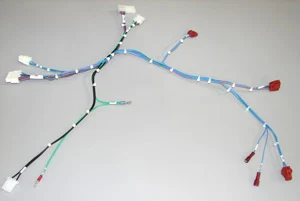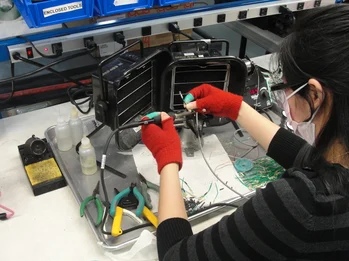Wire harness applications are used in nearly every conceivable household, commercial or industrial device – tools, equipment, machinery, hardware, household products – that transmits or relays electronic information or electrical power. The familiar harness is essential, if not an indispensable component in these devices. Wire harnesses are manufactured in various sizes and arrangements that relate to a device’s application and environmental requirements. These devices can be employed anywhere from temperature-controlled buildings or dwellings to harsh outdoor climates with wide temperature extremes, or even in marine environments at sea level.
 Components of wire harnesses consist of wires, connectors and terminals that are organized into compact, concise bundling systems. Designs vary significantly depending on system requirements. Some applications are no more than a simple bundle of loose wires grouped together into a single protective jacket. Other applications may require a much more complex assembly of dozens of individually overmolded cables and wires that feature breakouts that branch off in multiple directions to other junctions or termination points.
Components of wire harnesses consist of wires, connectors and terminals that are organized into compact, concise bundling systems. Designs vary significantly depending on system requirements. Some applications are no more than a simple bundle of loose wires grouped together into a single protective jacket. Other applications may require a much more complex assembly of dozens of individually overmolded cables and wires that feature breakouts that branch off in multiple directions to other junctions or termination points.
Finally, wire harnesses provide efficient wiring solutions for electrical devices and equipment that will significantly impact the overall performance, reliability, and stability of those products. Their application then, is critical to the manufacturing of properly functioning products in every major industrial sector. For a better understanding, consider how these 5 common industries rely on wire harness applications in their products:
1. Automotive Applications
To simply start an automobile, truck, motorcycle, tractor, and so on, relies on a variety of electronic controls and electrical devices to transmit signals and electrical power to turn the engine over and achieve ignition. The transmission of those signals is part of an immense wiring network that allows vehicles to function. That functionality is achieved through wire harness applications that connect the engine management system, lighting, power steering, power brakes, audio and entertainment system, electric windows, air conditioning and so on into an efficiently operating vehicle. With dozens of electronic units on board, it’s no surprise that an average car has thousands of wires stretching for over a mile in length to connect devices and operate systems. Wire harnesses are used to connect those devices and deliver electricity and electronic signals through the entire vehicle.
2. Manufacturing
 Complex wiring, cabling systems, and networks drive automated and robotic production and assembly lines found in today’s manufacturing plants and facilities. Wire harnessing applications connect power and signal conductors that control different systems within the same area or along the production line. Wire harnesses ensure connectivity and properly seal cabling and wires to ensure that production is fully optimized.
Complex wiring, cabling systems, and networks drive automated and robotic production and assembly lines found in today’s manufacturing plants and facilities. Wire harnessing applications connect power and signal conductors that control different systems within the same area or along the production line. Wire harnesses ensure connectivity and properly seal cabling and wires to ensure that production is fully optimized.
3. Medical Applications
In healthcare, electronic medical equipment, devices, and instruments are subject to heavy use, but also varying degrees of high and low intensity. The wire harness applications used in these devices must be durable, adaptable, and biocompatible. Whether the device is a defibrillator, drill, pacemaker, or imaging or radiological equipment, it must be able to function on demand without failure. Because of the variety of applications, wire harnesses for the medical sector come in all shapes and sizes. They differ from other wire harness assemblies used in other industries in that harnesses for medical applications must be bio-sensitive and in compliance with FDA regulatory controls and guidelines.
4. Communication Systems
Global connectivity requires an infrastructure that can send and receive data instantaneously anywhere around the world. Communication systems depend on specialized harnesses for an array of technologies and a wide range of applications. Wire harnesses are integral components in the assembly of hubs, routers, repeaters, modems, peripheral equipment, optical networks, broadband networks and much more. Wireless communication applications include DSL routers, satellite receivers, and RF.
5. Military Applications
Wire harness capabilities for any military application must meet stringent DoD (Department of Defense) specifications. Cabling and wiring used in military equipment is designed for applications subject to extreme environments and conditions. Military wire harnesses must be manufactured with components—wires, connectors, terminals—that are specified and/or approved for demanding military applications.


